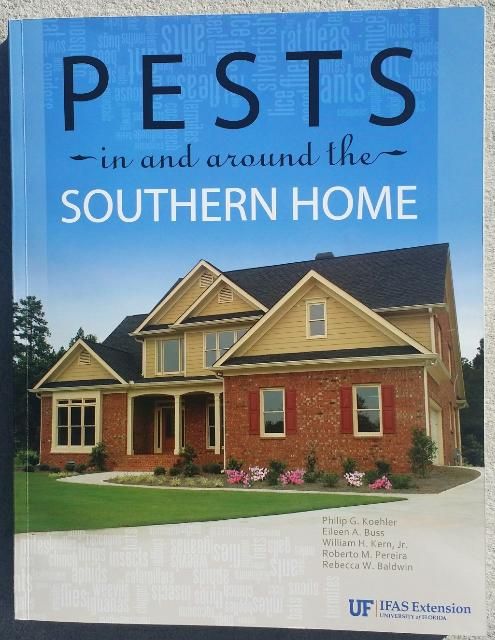
Several kinds of nonbiting flies can be found in and around farms, residences, and food-handling establishments. These flies cause annoyance and discomfort and can also be harmful to human and animal health. All filth flies have an egg, larva (maggot), pupa, and adult stage in their life cycle. The adult fly has two major wings and two reduced wings, called halteres. These reduced wings are knob-shaped balancing organs.
These flies are usually scavengers in nature, and many are capable of transmitting diseases to man. These flies can usually be grouped according to their habits and appearance as houseflies and their relatives; flesh flies, blow flies, and bottle flies; filter flies; soldier flies; and vinegar (fruit) flies.
House Fly
The house fly (Figure 1) is one of the most common of all insects. It is worldwide in distribution and is a pest in homes, barns, poultry houses, food-processing plants, dairies, and recreation areas. It has a tremendous breeding potential, and during the warmer months can produce a generation in less than two weeks. In many areas of Florida the house fly breeds continually throughout the year.

House fly eggs are laid in almost any type of warm organic material. Animal or poultry manure is an excellent breeding medium. Fermenting vegetation such as grass clippings and garbage can also provide a medium for fly breeding. The whitish eggs, which are laid in clusters of 75 to 100, hatch within 24 hours into tiny larvae, or maggots. In four to six days the larvae migrate to drier portions of the breeding medium and pupate. The pupa stage may vary in length considerably, but in warm weather can be about three days. When the adult emerges from the pupal case, or puparium, the wings are folded in tight pads.
The house fly crawls about rapidly while the wings unfold and the body dries and hardens. Under normal conditions this may take as little as an hour. Mating occurs immediately. A house fly may go through an entire life cycle—egg, larva, pupa to winged adult—in six to 10 days under Florida conditions. An adult house fly may live an average of 30 days. During warm weather two or more generations may be produced per month. Because of this rapid rate of development and the large numbers of eggs produced by the female, large populations build up.
House flies are strong fliers and can become widely distributed by flying, wind currents, vehicles, and animals. Generally, however, flies are abundant in the immediate vicinity of their breeding site. Under certain conditions, they may migrate one to four miles, but are usually limited to one-half to two miles.
House flies feed by using sponging-type mouthparts. As the fly moves about from one food source to another, it samples and eats its food by regurgitating liquid and dropping it on the food to liquefy it. Light-colored spots called fly specks are visible signs of this type of feeding. Darker fly specks associated with house flies are fecal spots.
The house fly's feeding and breeding habits, along with its persistence for invading homes and feeding on human food, enable the house fly to spread many intestinal diseases such as dysentery and diarrhea.
Resistance to insecticide is a complex problem associated with chemical control of insects. Recognized some more than 75 years ago, it is not a new problem. Resistance is the ability of an insect population to withstand exposure to insecticides, and this is acquired by breeding among insects that have survived previous exposures to an insecticide that did not wipe out the whole population. The surviving insects are resistant either because biochemical mechanisms (enzymes) enable them to quickly break down the insecticide or behavioral adaptations enable them to somehow avoid the insecticide.
Flesh Flies
Flesh flies (Figure 2) are a scavenger fly species that usually feeds on carrion or meat scraps in garbage. They are medium-to-large flies and usually have three dark thoracic stripes and a mottled abdomen. Many of the common species have a red tip on the abdomen.
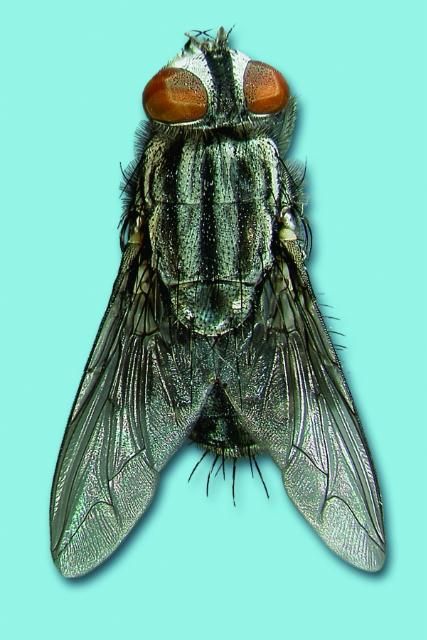
Female flesh flies retain their eggs within their body until they are ready to hatch. The larvae are deposited directly onto the food the immature will be eating. The life cycle for the common species can be completed in eight to 21 days.
The preferred breeding media around residences are decayed flesh, spoiling meat, and manure. Usually garbage cans, meat scraps, and dog food left outside are abundant sources of flesh fly breeding. Flesh flies can breed in dead rodents and birds in attics or wall voids of houses.
Blow Flies and Bottle Flies
There are quite a few species of blow flies (Figure 3) and bottle flies (Figure 4) that are found in and around residences. The green bottle flies, blue bottle flies, and bronze bottle flies are particularly abundant in Florida. In urban areas these flies may be more abundant than house flies.
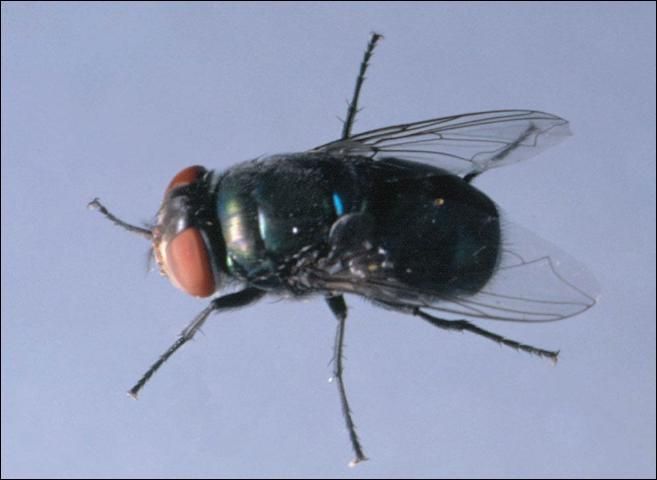
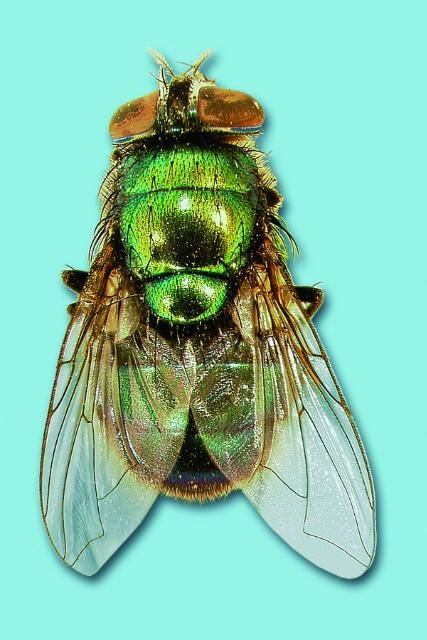
The blow flies and bottle flies usually have a metallic blue, green, or both colors on the thorax and abdomen. These flies are strong fliers and range many miles from breeding places. They are abundant during the warm summer months.
Blow flies and bottle flies can breed on dead rodents and birds in attics or wall voids of houses. They usually breed in meat scraps, animal excrement, and decaying animal matter around houses. The adult flies are quite active inside and are strongly attracted to light. The mature larvae are often a problem when they migrate from breeding areas to pupate.
Blow flies usually lay eggs on dead animals or decaying meat. Garbage cans have been known to produce 30,000 blow flies in one week. The life cycle usually lasts nine to 21 days from egg to adult.
Filter Flies, Moth Flies, or Drain Flies
Filter/moth/drain flies (Figure 5), belong to the family of flies generally called moth flies, because their scale-covered wings resemble those of a moth. They are 1/16 to 1/8 inch (1.6 to 3.2 mm) in length and light gray to tan. Their life cycle is seven to 20 days. Adult flies have the body and wings covered with dense, long hairs. Moth/filter flies breed in decomposing organic material, such as moist plant litter, garbage, sewage, and around kitchen or bathroom sinks and water traps in plumbing fixtures.
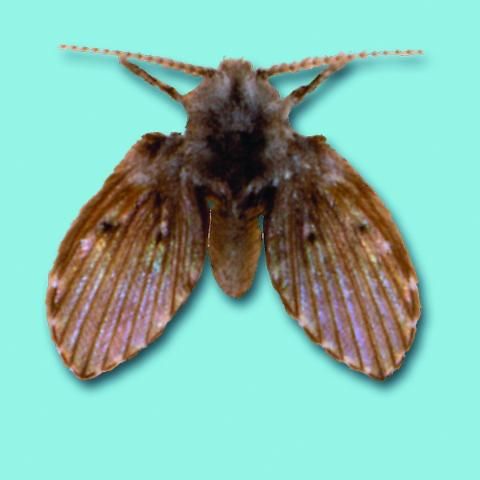
Soldier Flies
The soldier fly (Figure 6) is a widespread pest that occasionally becomes a problem in homes. The adult is a large fly about 1 inch (2.5 cm) long with two large, translucent areas on the abdomen. The fly behaves like a wasp and is similar in appearance to a mud-dauber wasp. The larvae prefer to feed on human or animal excrement, although they have also been known to breed in honeybee colonies killed in walls of houses.

Most frequently the larvae are found in bathrooms migrating from the septic tank or sewer line. The presence of the maggot under such circumstances indicates the septic tank or sewage line is not working properly.
Vinegar (Fruit) Fly
Fruit flies (Figure 7) are nuisance pests and contaminators of food. Fruit flies usually breed in fruit, dirty garbage containers, or slime in drains, feeding on yeasts that grow on organic matter. Each adult lays about 500 eggs that hatch, and the larvae mature to adults in nine to 12 days. These flies are readily attracted to fruit, vegetables, and soda bottles and cans.
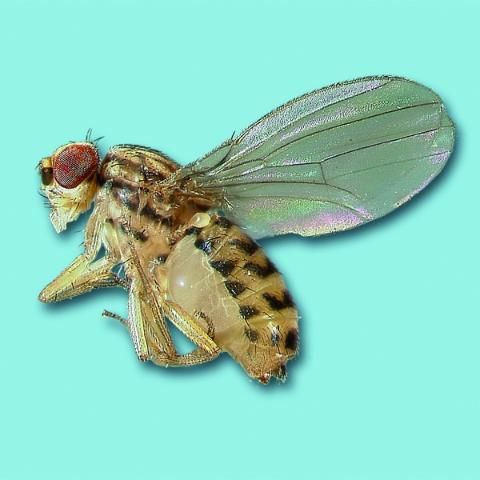
Eye Gnats
Eye gnats (Figure 8) are small, shiny black flies about 1/6 inch (4.2 mm) in length. The adults are strongly attracted to moisture around the eyes and nose of people outdoors. In midsummer large numbers of eye gnats persistently hover around the face, causing considerable annoyance. Often eye gnats enter the homes through open doors or windows. They are strongly attracted to light and observed mainly on windows in large numbers. These flies have been implicated with infecting children and adults with pink eye.
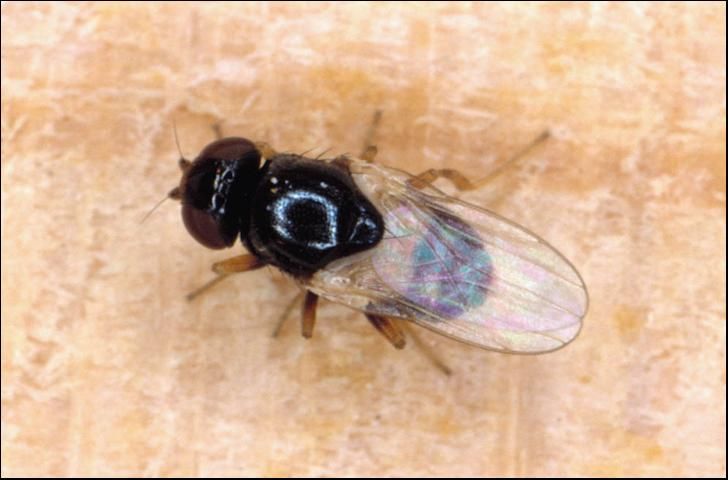
Eye gnats breed in soil containing considerable organic matter, decaying vegetation, and animal excrement. The life cycle varies from seven to 28 days, depending on the temperature and moisture.
Humpbacked Flies
Humpbacked flies (Figure 9) are about 1/8 inch (3.2 mm) long with a small head and large thorax, causing the fly to have a hump-backed appearance. Humpbacked flies breed in decaying vegetation, animal debris, garbage, and in ant and termite nests.
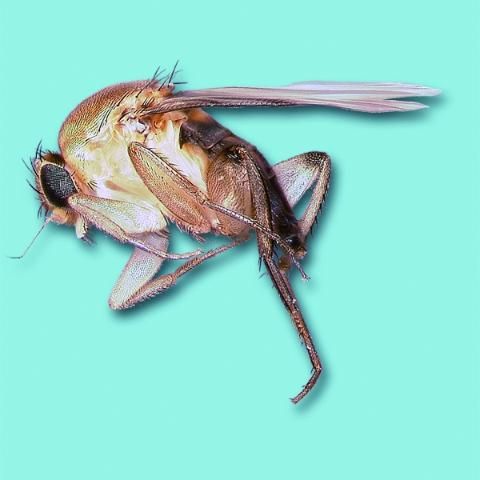
Dump Flies
Dump flies (Figure 10) are about 1/4 inch (6.4 mm) long, and black with a shiny thorax and abdomen. Dump flies breed in garbage and fowl excrement. The larvae are predacious on larvae of other flies.
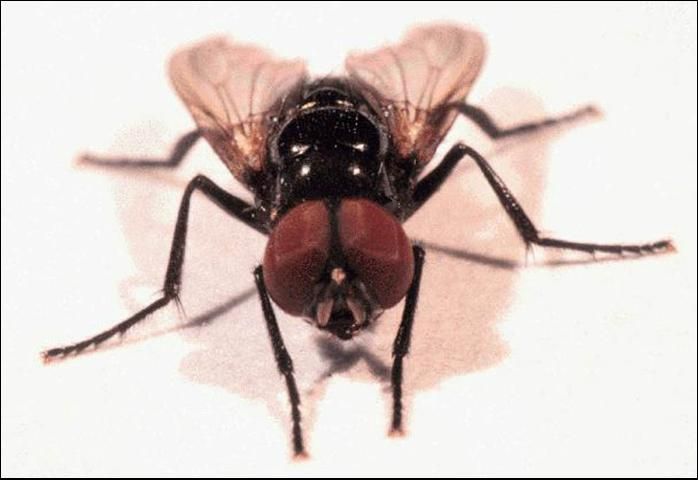
Secondary Screwworm Flies
Secondary screwworm flies (Figure 11) are about 1/4 inch (6.4 mm) long, and green with a shiny abdomen and thorax with thorax marked lengthwise with three dark stripes. Their life cycle is nine to 39 days. They breed in dead tissue surrounding wounds in animals, fresh-cut meats, and garbage.
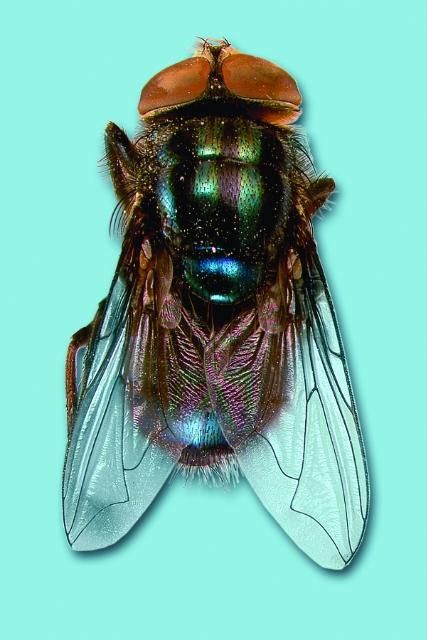
Control of Filth Flies
Sanitation is still the best method of controlling filth flies in and around the home and on the farm. Flies seek breeding places where garbage, animal droppings, or vegetation residues accumulate. Locate and thoroughly clean such places. Dry, spread, or somehow dispose of dog, cat, or other animal excrement. Do not let garbage accumulate in the open, and make sure garbage cans have sound bottoms and tight-fitting lids.
Good-fitting screens on windows and doors are essential in preventing flies from entering homes and kitchens. In areas with high humidity screens last longer when made of aluminum, plastic, or fiberglass.
To kill flies inside the home use a space spray or aerosol. Make sure to check product labels to ensure proper use. Release the mist from the aerosol for a few seconds around the room and keep the room closed for 10 to 15 minutes. Flies inside the room will die. Aerate the room before allowing people or pets to reenter. Flies often enter houses through cracks and crevices around windows and doors. Indoors, these cracks and crevices can be treated with other types of products.
There are some liquid spray products labeled for outdoor barrier treatment. The outdoor barrier is applied to areas where flies rest before entering the house, such as walls in a carport, near porches, or under eaves. Other locations to treat would be around doors and windows. Follow dosage and application directions on the container label.
Fly baits are usually available as granules, but liquid products also exist, including ones in aerosol bottles for easy application. The formulations contain insecticide and sugars that serve as feeding attractants for the flies. Some baits also include 2-9-tricoseme, a sex attractant for flies. Baits should be applied to areas where adult flies are active. Protect dry baits from getting wet because wet baits are not as effective for fly control, and aerosol and othe wet baits can be washed off by precipitation.
Control of eye gnats is difficult. It is often hard to destroy breeding sites over the many acres of land where eye gnats breed. For personal protection outdoors, repellents may be applied to the skin. Indoors, space sprays will kill adults that are trapped in the house.